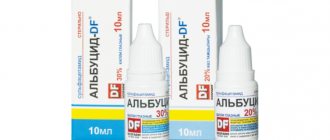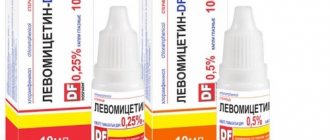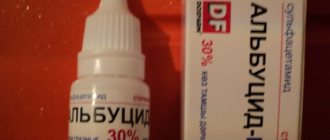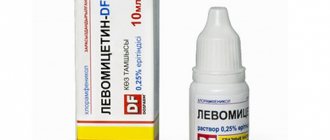What is Albucid?
This drug belongs to sulfonamides. The active substance of the drug is sodium sulfacyl. For treatment, an aqueous solution is used that penetrates into the deep tissues of the eye. Its action is aimed at creating unfavorable conditions for the further proliferation of bacteria that provoke the development of the disease.
Release form "Albucid" - eye drops of 2 types. They differ in the concentration of the active component: for adults - 30%, for children - 20%.
"Albucid" is acceptable for use from the first year of a baby's life, but after agreement with the pediatrician. Therefore, when choosing which is better for children - Albucid or Levomycetin, preference is given to the first, since its only contraindication is individual hypersensitivity.
Indications for use:
- diseases of the conjunctiva of various etiologies;
- gonorrheal eye disease;
- formation of ulcers on the cornea;
- ocular infectious pathologies caused by bacteria susceptible to the action of sulfacetamide.
The medicine is also used to prevent blenorrhea in children.
During treatment, the drug is instilled 2-3 drops into each eye up to 6 times a day. The duration of use is agreed with the attending physician, but not less than 5 days.
Albucid for children with a runny nose
Albucid should be dripped into the nose in case of bacterial invasion in the nasal cavity. Albucid can be used from an early age - from infancy. For young children, the doctor prescribes the dosage of the drug independently, while for older children it is recommended to take up to 4 instillations of 2 drops into each nasal passage.
If it seems difficult for you to introduce a few drops of the drug into the child’s nasal cavity, you can moisten a gauze turunda in the drug and, holding it with tweezers, carefully treat the nasal mucosa.
Pediatricians turn to this drug because of the wide range of pathogenic microorganisms it kills. A quick local effect on the focus of the inflammatory process allows you to avoid dangerous complications, as well as the use of systemic antibiotic drugs.
Characteristic differences of Levomycetin eye drops
"Levomycetin" is a widely used antibiotic, part of the chloramphenicol group. The active ingredient is chloramphenicol. The product also contains auxiliary components, such as boric acid and purified water.
The drug is active against gram-positive and gram-negative microorganisms, as well as strains of bacteria that are resistant to the action of streptomycin, sulfonamide, and penicillin.
The drug inhibits protein synthesis of harmful microorganisms, which leads to their death. Therefore, which is better - “Albucid” or “Levomycetin” for conjunctivitis can be judged depending on the stage of development of the disease. At the initial stage, the first drug is considered preferable, and if it fails, it is recommended to use the second.
"Levomycetin" is active against a wider range of pathogens. Thanks to this, inflammation is noticeably reduced after 2-3 times of use.
Indications for use:
- conjunctivitis;
- keratoconjunctivitis;
- blepharitis;
- keratitis;
- barley.
When used, an increased concentration of chloramphenicol is fixed in the vitreous body, iris, and cornea, but the active component does not penetrate into the crystal.
In the first days of treatment, the medicine is instilled into the conjunctival sac, 2-3 drops every 1-4 hours, depending on the severity of the disease. When the inflammatory process decreases, the medicine is administered 1 drop every 4-6 hours. The maximum duration of treatment is 2 weeks.
Contraindications and side effects
This drug is very popular due to the fact that it is highly effective and has a small range of contraindications and side effects.
Among the contraindications, the only contraindications can be noted: intolerance to sulfonamide drugs. You should also use the drug with caution if other medications based on silver salts are prescribed.
Among the side effects noted:
- When used according to the regulations, you may experience irritation or an allergic reaction;
- If accidentally ingested, allergies and dyspepsia may also occur.
Albucid, as well as Albucid for children with eye diseases, has proven itself well.
General properties of drugs
It is difficult to answer unequivocally which is better, “Levomycetin” or “Albucid”. Both of these drugs are characterized by a bactericidal effect. Their use is acceptable for both adults and children. The level of safety when using eye drops is high, since the active component is not able to penetrate into the blood in high concentrations and affect the functionality of vital organs.
Which is better - Albucid or Levomycetin eye drops - for conjunctivitis or another disease, it is also impossible to say categorically. Both drugs are effective, despite the fact that they belong to different drug groups. They inhibit the development and reproduction of pathogens, and also stop the inflammatory process, but in different ways.
Side effects may occur with both medications. Both medications can cause burning and itching, which is accompanied by profuse lacrimation, redness of the conjunctiva and a gritty sensation. If unpleasant symptoms appear, the eyes should be rinsed and therapy should be stopped. The possibility of further treatment should be discussed with your doctor.
Most popular means
Our eye is covered by a very delicate mucous membrane - the conjunctiva. And the cornea is not protected by anything at all. Therefore, agents for local treatment of infections should minimally irritate the structures of the eyeball and at the same time be as effective as possible.
Inflammation of the eyes associated with a rash on the scalp or face. Suspicion of a foreign body in the eyes. Previous conjunctivitis in the recent past. Eye surgery or laser treatment in the past 6 months. Current use of other eye drops or eye ointment.
Soft contact lenses should not be worn during treatment with chloramphenicol eye drops due to absorption of the preservative onto the lens, which may cause damage to the lens. It is recommended to avoid all types of contact lenses during eye infections. The packaging will provide the following information.
Two drugs best meet these criteria:
- One is from the group of sulfonamides: sulfacetamide. Its 30% solution is known to us as Sulfacyl sodium or Albucid (in pediatric practice, a 20% concentration is used).
- The second is the only representative of the chloramphenicol group - Levomycetin. In ophthalmology, its 0.25% aqueous solution is used.
These two drugs are widely used due to their wide spectrum of action and the possibility of obtaining their water-based solutions.
If symptoms do not improve within 48 hours, talk to your doctor. Seek immediate medical attention at any time if symptoms worsen. Do not use if you are allergic to chloramphenicol or any ingredient. Phenylmercuric nitrate is a skin irritant. Topical use to the eye is associated with mercurialtosis and atypical ring keratopathy.
Concomitant administration of Chloramphenicol with other drugs that can reduce bone marrow function should be avoided. Safety for use during pregnancy and lactation has not been established. Chloramphenicol may be absorbed systemically after use of eye drops and may cross the placenta and appear in breast milk. Therefore, this product is not recommended for use during pregnancy and lactation.
Difference between them
It is quite difficult to find fundamental differences between these medications, since they have different active ingredients. Therefore, it makes no sense to judge whether “Levomycetin” or “Albucid” is better.
A comparative table of these drugs is presented below.
| Characteristic | "Levomycetin" | "Albucid" |
| Action | Inhibits a wide range of eye pathogens | Active against streptococci, staphylococci, gonococci |
| Pharmacokinetics | Inhibits protein synthesis in pathogen cells, which provokes their death | It is not capable of destroying bacteria, but creates unfavorable conditions for their reproduction and further spread |
| Harm | The level of toxicity for the body is lower, since it does not enter the bloodstream. But with prolonged use it can cause the development of aplastic anemia | Has fewer contraindications. The only limitation is the individual hypersensitivity of the component. Suitable for use in the first year of life and during lactation |
Based on this, we can judge that any of these medications have advantages and disadvantages that should be taken into account when carrying out therapy.
Price of Albucid and drug analogues
There are many analogues of Albucid on the pharmaceutical market (the price of which is 80-90 rubles). The names of the most famous of them:
- Levomycetin – 20 rubles;
- Floxal – 145-170 rubles;
- Ciprofloxacin eye drops – 18 rubles.
Let's compare Albucid with them.
Albucid or Levomycetin - which is better?
Levomycetin is an effective drug that is considered more suitable for use in children, as it does not cause tingling or irritation in the eyes. Its cost is really ridiculous.
The disadvantage of this drug is its obsolescence, and therefore many strains have already developed sensitivity to the active drug - chloramphenicol.
Also, in case of overdose, it can cause dangerous symptoms in newborns (including arrhythmia, cardiovascular failure).
Cannot be used by pregnant and lactating women and children under 4 months.
Albucid or Floxal: which is more effective?
This drug is slightly more expensive than Albucid. Its main difference is the active substance (ofloxacin), which affects pathogenic microorganisms other than Albucid (Neisseria, Legionella, Escherichia, mycoplasma, enterobacteria, and so on).
Albucid and ciprofloxacin - what is the difference?
Ciprofloxacin is a cheap and effective drug that has a wide spectrum of antimicrobial activity, destroying staphylococci, salmonella, shigella, mycobacteria, legionella, listeria, some spirochetes, clostridia and so on.
It has a different spectrum of action from Albucid. It is contraindicated for children under 15 years of age, as well as for pregnant and lactating women, so it obviously cannot be called children’s. It has many contraindications and side effects.
Often, when treating various pathologies of the visual organs, patients are confused about the drugs Levomycetin and Albucid. Let's figure out how interchangeable they are and which one is better.
What is better - “Albucid” or “Levomycetin” (eye drops)?
Both of these drugs are effective against bacterial damage to the organs of vision.
"Albucid" is an affordable remedy that is used for uncomplicated eye diseases, if the pathology does not threaten serious health complications. It is the drug of first choice in the treatment of infectious diseases due to its good tolerability. But sometimes it does not bring the desired result, since many strains of bacteria have developed resistance to its action.
In this case, Levomycetin comes to the rescue. It is considered a backup backup drug that helps in difficult situations when, against the background of an infectious process, there is a threat of serious visual impairment. Therefore, there is no need to say which is better - “Levomycetin” or “Albucid”. They simply complement each other.
Levomycetin
Drops based on chloramphenicol are intended to eliminate infectious lesions in the visual area. The product eliminates the inflammatory process that develops against the background of:
- endophthalmitis;
- conjunctivitis;
- meibomite;
- iridocyclitis;
- blepharitis;
- dacryocystitis.
The drug can be prescribed to patients over 2 years of age. Side effects resulting from the application of the medication include:
- allergic reactions;
- increased secretion of tear secretion;
- rashes on the dermis;
- itching sensation;
- redness of the eyeball;
- appearance of irritation.
The drug is contraindicated in the following cases:
- pregnancy;
- breastfeeding;
- for pathologies of the skin;
- individual intolerance to the components of the drug.
Characteristics of Albucid drops
Sulfacyl sodium (Albucid) is a sulfonamide drug that has a wide spectrum of antimicrobial action. The active substance in this drug is sulfacetamide. Its effect is predominantly local, but it is still partially absorbed through the inflamed mucous membrane and enters the bloodstream at the systemic level.
The use of Albucid as prescribed by a doctor is appropriate when inflammation affects:
- conjunctiva;
- edges of eyelids;
- cornea of the eye;
- lacrimal sac;
- choroid of the eye.
This drug is also used to prevent infectious complications in the complex treatment of injuries and the consequences of exposure to a thermal agent on the eyeball or tissue around it. Drops are used to treat adults, as well as in pediatrics for patients older than 2 months. Read more about Albucid for children →
Sulfacyl sodium is sold in dropper bottles of 5 or 10 ml. The solution is clear, colorless or yellowish.
According to the instructions for use, Albucid 1-2 drops are applied into the lower pocket between the eyelid and the eyeball 5-6 times a day. The therapeutic course can last 7–10 days. As the condition improves, the number of instillations is reduced.
Most patients complain that when Albucid is instilled, they experience burning, stinging and itching in the eyes. Usually these sensations pass quickly. When using the drug, side effects may also occur: lacrimation, transient blurred vision, local or systemic allergic reactions, superinfections.
"Dexa-Gentamicin": a potent drug
This substitute for the drug "Albucid" (analogue) has a dual effect on the human visual organs. This fact distinguishes the drug from the previously announced product.
- Dex-Gentamicin eye drops eliminate bacterial flora and prevent further development of infection due to the active substance gentamicin sulfate.
- The drug has anti-inflammatory and antiallergic effects due to the presence of dexamethasone, a glucocorticosteroid component.
This product copes well with eye infections, allergic reactions, and drops can also be used for preventive purposes. Unlike the original medication (Albucid drops), the drug Dexa-Gentamicin has many contraindications: viral eye infections, mycobacterial infections, fungal processes, increased intraocular pressure, corneal damage. Do not use this medicine for more than two to three weeks in a row. Due to the fact that the medicine contains a hormonal substance, the drug should not be used together with other drugs for the treatment of eye diseases. More detailed information about the possibility of complex therapy should be obtained from an ophthalmologist.
Comparison of drugs
Composition and action
The drug Albucid consists of an active component - sulfacetamide, which has pronounced antibacterial activity. The substance easily penetrates the tissue structures of the eye and suppresses the proliferation of pathogenic microorganisms, as a result of which they die. "Albucid" is sold in the form of drops used for eye drops. Its absolute analogue, Levomycetin, consists of another main ingredient, namely chloramphenicol. It also has an antibacterial effect, i.e. it stops the growth and reproduction of pathogenic cells by disrupting intracellular protein synthesis.
Prescriptions and contraindications
In ophthalmology, Albucid eye drops are actively used for conjunctivitis, purulent ulcerative lesions of the cornea and blepharitis. The medicine is also widely used for the prevention of purulent inflammation of the optic organ in newborns, as well as in patients who have undergone ophthalmic surgery. Albucid is often used to treat barley. "Levomycetin" also effectively treats blepharitis, inflammatory damage to the mucous membrane and eyelids of the eye. Secondary bacterial infections are also susceptible to chloramphenicol-based ophthalmic drops.
Contraindications to Albucid include personal intolerance to any of the components. The medicine has no other restrictions on its use and can be prescribed even to children immediately after their birth. A local antibiotic is not contraindicated during pregnancy.
Levomycetin has a much longer list of contraindications and includes such pathologies as:
- hypersensitivity to the components of the drug;
- impaired activity of the kidneys and liver in a chronic form;
- skin pathologies;
- G6PD deficiency.











